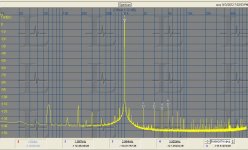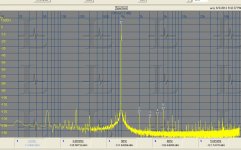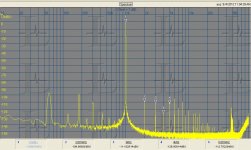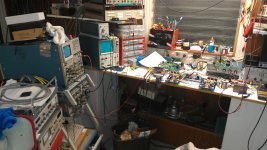Richard, the Active Twin-T schematic is here -- Active Twin-T notch filter. I'm using an OPA1641 for the input amp at the moment, but the OPA134 works just as well. I need to update the performance pix with current results, but the noise floor says a lot.
I can't see any distortion from the filter, but there has to be some there somewhere. With careful attention to capacitor size -- not too small, so as not to be confounded by stray C -- the T-T will work at 100kHz if you need to go that high. It also can be configured easily for spot frequencies and use a *lot* fewer parts -- and go in a smaller box.
As to the best sound module -- clearly having a full 192kHz Fs is important for both ADC and DAC. I believe that all the ADCs running at this sampling frequency are sigma-delta types, which can make higher frequency noise an issue due to the noise-shaping system. I would like to have an external USB ADC box that does 18 or more bits at 1MHz Fs. But I'm no good with digital design and building one is not in my set of cards. Maybe someone here is up to that -- I think the chips are out there.
I can't see any distortion from the filter, but there has to be some there somewhere. With careful attention to capacitor size -- not too small, so as not to be confounded by stray C -- the T-T will work at 100kHz if you need to go that high. It also can be configured easily for spot frequencies and use a *lot* fewer parts -- and go in a smaller box.
As to the best sound module -- clearly having a full 192kHz Fs is important for both ADC and DAC. I believe that all the ADCs running at this sampling frequency are sigma-delta types, which can make higher frequency noise an issue due to the noise-shaping system. I would like to have an external USB ADC box that does 18 or more bits at 1MHz Fs. But I'm no good with digital design and building one is not in my set of cards. Maybe someone here is up to that -- I think the chips are out there.
192 KHz Delta Sigma ADC's don't necessarily mean high noise at high frequencies.
This is a quick capture of the distortion spectra (of the ADC, the source is significantly better) of a 1 KHz low distortion source. The ADC is an AKM AK5394A, which is a reasonable choice and used in some current mid priced products. Adding a twin T would get better resolution on the distortion if you are really concerned about distortions below 120 dB. (The opamps on the ADC board are JRC 5534's, I have not tried others yet.)
Getting this performance from an internal card would be difficult but possible, however an external ADC will give better results usually.
This is a quick capture of the distortion spectra (of the ADC, the source is significantly better) of a 1 KHz low distortion source. The ADC is an AKM AK5394A, which is a reasonable choice and used in some current mid priced products. Adding a twin T would get better resolution on the distortion if you are really concerned about distortions below 120 dB. (The opamps on the ADC board are JRC 5534's, I have not tried others yet.)
Getting this performance from an internal card would be difficult but possible, however an external ADC will give better results usually.
Attachments
The 60 Hz was lazy setup on my part. I usually run a separate ground wire between the chassis and the demo board, but not this time.
I am not sure what uses this chip today. I believe its used in several pro ADC's and it might be in some of the better mid level ADC's.
I'm using the AKM demo board but laying out a board for it is not too difficult. If I weren't so busy I would do it. I may be able to get someone to attempt it. The chip is $22 for one at Digikey.
I am not sure what uses this chip today. I believe its used in several pro ADC's and it might be in some of the better mid level ADC's.
I'm using the AKM demo board but laying out a board for it is not too difficult. If I weren't so busy I would do it. I may be able to get someone to attempt it. The chip is $22 for one at Digikey.
ADC with twin T -
I think I'll use the AKM ADC and add the twin-T to it. can you give source of demo board and approx price? Thx - RM
The 60 Hz was lazy setup on my part. I usually run a separate ground wire between the chassis and the demo board, but not this time.
I am not sure what uses this chip today. I believe its used in several pro ADC's and it might be in some of the better mid level ADC's.
I'm using the AKM demo board but laying out a board for it is not too difficult. If I weren't so busy I would do it. I may be able to get someone to attempt it. The chip is $22 for one at Digikey.
I think I'll use the AKM ADC and add the twin-T to it. can you give source of demo board and approx price? Thx - RM
Last edited:
Thank you, both.
before taking the plung -- is there anything better than AK5394A or E-MU suggested that may exist today?
TI's PCM4222EVM evaluation board is claimed to be really outstanding. Check out the spectra on this:
http://www.diyaudio.com/forums/solid-state/1565-diy-distortion-analyzer-analysis-14.html#post2664662
Pretty dang good I think.
PCM4222 EVM
Here is the same source measured with the PCM4222 EVM. I did not get the same results or even nearly so as the linked test. Distortion products are higher. Key difference- I am sampling at 192 KHz. Changing the sample rate is a real PITA on these. I had to get the local FAE to get the board running and he had to call several people at TI for guidance.
It also shows me that I have some jitter in the on board clocking on the AKM board (its not well done and I should completely reconstruct it).
The noise above the oscillator frequency is lower than the noise below (??). The noise shaping start up at 50 KHz on this chip. I'll leave it running and recheck the distortion in a few hours to see if its better. I also need a better power supply for these guys.
Here is the same source measured with the PCM4222 EVM. I did not get the same results or even nearly so as the linked test. Distortion products are higher. Key difference- I am sampling at 192 KHz. Changing the sample rate is a real PITA on these. I had to get the local FAE to get the board running and he had to call several people at TI for guidance.
It also shows me that I have some jitter in the on board clocking on the AKM board (its not well done and I should completely reconstruct it).
The noise above the oscillator frequency is lower than the noise below (??). The noise shaping start up at 50 KHz on this chip. I'll leave it running and recheck the distortion in a few hours to see if its better. I also need a better power supply for these guys.
Attachments
OK, thanks. I was planning on battery power. I'd be interested to know if there's a better ADC out there.
How did you get the signal into your computer? Did you use the S/PDIF RCA jacks or the AES jacks? I bought a miniStreamer from miniDSP that is a bidirectional I2S to USB link, since I only have USB available on my laptop.
How did you get the signal into your computer? Did you use the S/PDIF RCA jacks or the AES jacks? I bought a miniStreamer from miniDSP that is a bidirectional I2S to USB link, since I only have USB available on my laptop.
I'm using SPDIF coax to a Juli@ card. I am also using an external OXCO 24.576 oscillator with really low jitter. The Ministreamer would be a good choice. Those guys are very good. The demo boards support I2S and I think you can configure the Ministreamer so the clock schemes will work.
For ADC use there is very little possible difference between AES and SPDIF since the information is not time critical data like the DAC side.
For ADC use there is very little possible difference between AES and SPDIF since the information is not time critical data like the DAC side.
I'm using SPDIF coax to a Juli@ card. I am also using an external OXCO 24.576 oscillator with really low jitter. The Ministreamer would be a good choice. Those guys are very good. The demo boards support I2S and I think you can configure the Ministreamer so the clock schemes will work.
For ADC use there is very little possible difference between AES and SPDIF since the information is not time critical data like the DAC side.
Someone mentioned the advantages of using balanced connections for test and measurement. I wonder if the balanced AES signal would be cleaner?
Also, how would I interface the balanced inputs of the evaluation board with a single ended circuit?
RE PCM4222: Things I'm not crazy about -- that bundle of trash at around 48kHz, which has been an issue for me with the EMU 0204, too. Is that actually from the ADC? And the higher distortion with lots of products way on out....
Maybe they were not enclosed in a good RFI proof box?
RFI Shielding?
Not really. The generator is in the stack on the left under the aluminium chassis and the ADC is on the right on top of the Heathkit supply connected through 8 feet of coax. Its identical to the setup used with the AKM demo board. Neither are particularly good.
The big board in front is what I should be working on. . .
Not really. The generator is in the stack on the left under the aluminium chassis and the ADC is on the right on top of the Heathkit supply connected through 8 feet of coax. Its identical to the setup used with the AKM demo board. Neither are particularly good.
The big board in front is what I should be working on. . .
Attachments
The bundle of modulated spikes at 48kHz has nothing to do with EMI or RFI -- it's something from the ADC or the interface, and since I see the same thing in the EMU 0204 with a different interface, I think it's the ADC.
Well, I doubt you're going to find something better that doesn't cost the moon. I've been looking at various sound cards and USB/Firewire interfaces for pro audio and none seem to have lower noise. The M-Audio and Focusrite products seem to be popular and well regarded, but don't know for sure. Do you have any suggestions for a better ADC/DAC? I checked National Instruments and they only have 16 bit interfaces.
Last edited:
- Home
- Design & Build
- Equipment & Tools
- Low-distortion Audio-range Oscillator



